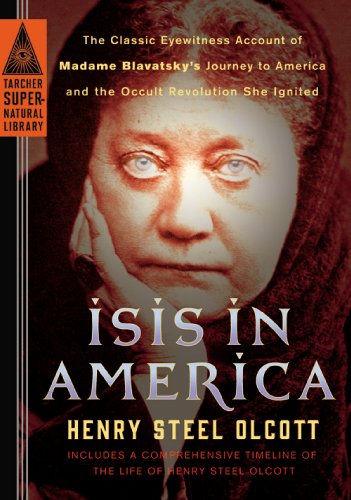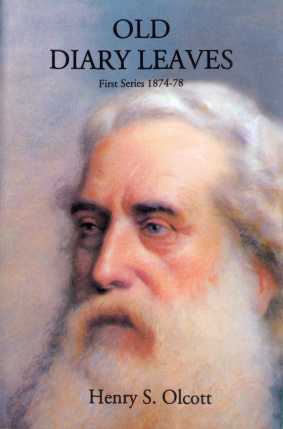Thursday, November 21, 2013
Blavatsky News
* Tibet: an unfinished story by Lezlee Brown Halper and Stefan Halper is a 320 page study set to be released April 1, 2014 by Oxford University Press, USA. The Tibet Post International conveys the publisher’s announcement:
This book traces the origins and manifestations of the Tibetan myth, as propagated by Younghusband, Madam Blavatsky, Himmler, Acheson and Roosevelt. The authors discuss how, after WW2, Tibet — isolated, misunderstood and with a tiny elite unschooled in political–military realities –– misread the diplomacy between its two giant neighbours, India and China, forlornly hoping London or Washington might intervene.
Lord Rowan Williams, Master of Magdalene College, Cambridge and former Archbishop of Canterbury, says about the book: “The West is — understandably —deeply impressed with the spiritual energy and depth of the Dalai Lama; but we have long needed a judicious and comprehensive overview of how the current indefensible situation in Tibet arose that will take us beyond vague sympathy. This book offers just such an overview, spelling out how short-term needs of the Cold War and the tunnel-vision of pro-Taiwanese lobbyists in the USA combined with the political and moral radar of the world. It is a tragic and shameful story, told here with clarity and challenge.”
* A Research Workshop on “Theosophical Appropriations: Kabbalah, Western Esotericism and the Transformation of Traditions” will be held December 13-18 in Beer-Sheva, Israel, at Ben-Gurion University of the Negev, Beer-Sheva. According to the program:
It seeks to explore the diverse and complex ways in which the Theosophical Society and related currents confronted, adapted and transformed various religious and cultural traditions. The workshop will provide a platform for high-profile international speakers and experts in Theosophy and related movements. They will address a wide range of issues, groups and individuals associated with and derived from Theosophy in a number of different countries at during different periods. Issues to be considered include the transformation of Kabbalistic doctrines in Theosophy, the nature of Theosophical doctrines, their appeal and historical and cultural contingency, the relationships and possible tensions between different elements within them and the relation between Theosophy and Jewish, Hindu and Buddhist thought.
So far some 30 participants will be presenting papers on various aspects of Theosophy, Spiritualism, and Anthroposophy. A number of the presentations reference Mme. Blavatsky, and the program can be viewed here.
Sunday, November 10, 2013
Blavatsky and Buddhism in England
Mme. Blavatsky is mentioned in passing as an influence behind the reintroduction of Buddhism in Britain in the 1920s in Alison Falby’s “Buddhist Psychologies and Masculinity in Early Twentieth Century Britain.” Falby’s contribution is the opening chapter in Men, Masculinities and Religious Change in Twentieth-Century Britain edited by Lucy Delap and Sue Morgan and recently published Palgrave Macmillan (352 pages, hardcover, $92.00). The piece focuses on the interaction between two newly founded Buddhist groups in London in the 1920s and the competition and collaboration that emerged. Col. Olcott’s contribution to the Buddhist revival in Sri Lanka, as defined by Stephen Prothero, is referenced as a prelude to introducing his protégé Dharmapala.
Attempts had been made to form organisations for the promulgation of Buddhism in England but none had had a lasting effect until Christmas Humphreys helped form the Buddhist Lodge of the Theosophical Lodge in 1924 in London. Dharmapala’s Mahabodhi Society also established itself in London at that time and became a major contender of the Buddhist Lodge for Buddhist legitimacy. A letter published in the Mahabodhi Society’s journal, The British Buddhist, from 1927 is typical of the group’s response: “To certain members of the Buddhist Lodge it seems that Madame Blavatsky is greater than the Buddha.” Falby writes, “In claiming the legitimacy of their own knowledge [Buddhist] Lodge members indicated that they did not need bhikkhus.”
 |
| DT Suzuki, Christmas Humphreys and Edward Conze |
Thursday, November 7, 2013
Blavatsky and the American West
A major exhibition on the interaction of Theosophy and the Arts will be held next year at the Nora Eccles Harrison Museum of Art at Utah State University. “Enchanted Modernities: Mysticism, Landscape and the American West” will be on view from April 14 to December 10, 2014. The focus will be “Theosophical thought and the western landscape.” The program explains:
“…It is in America that the transformation will take place, and has already silently commenced.” —Madame Blavatsky. With these words, written in The Secret Doctrine in 1888, Helena Blavatsky drew a direct connection to the dynamic energy of 19th century Americanism and the Theosophical Society she founded. Later, she and her successors would specify the American West as the site for a rebirth and re-enchantment of humanity, drawing those seeking spiritual fulfillment outside of organized religion to the dramatic landscapes of California, Arizona, Utah, and New Mexico. The syncretic nature of Theosophy encouraged individualism in belief, fitting well the generalizations of individuality and personal agency often used to characterize the American West.
Amongst those that came to the West seeking spiritual meaning were visual artists and composers inspired both by contact with Theosophical institutions or texts and the transcendent landscapes of the West. This exhibit will take as a point of departure this intersection of influences: Theosophical thought and the western landscape, as an invitation to explore the role of Theosophy on Western American art and music in the 20th century.
The work of the Southern California landscape school, especially that of Maurice Braun (1877-1941), awaits examination. Braun spent time at the Theosophical community at Point Loma (where is his “Portrait of Dr. Hyman Lischner” ?), as did a fellow artist, Edith White (1855-1946). While White is overshadowed by Braun’s rugged California landscapes, her studies of roses still hold a charm of their own.
 |
| Edith White, Red Roses 1902 |
Sunday, November 3, 2013
Isis in America
 The American publisher Tarcher will be reprinting the first volume of H.S. Olcott’s Old Diary Leaves as part of its intended Tarcher Supernatural Library. Other titles in the series will include Hans Holzer’s Ghost Hunter: The Groundbreaking Classic of Paranormal Investigation and Sax Rohmer’s Romance of Sorcery: The Famous Exploration of the World of the Supernatural. Old Diary Leaves will be retitled Isis in America: The Classic Eyewitness Account of Madame Blavatsky's Journey to America and the Occult Revolution She Ignited.
The American publisher Tarcher will be reprinting the first volume of H.S. Olcott’s Old Diary Leaves as part of its intended Tarcher Supernatural Library. Other titles in the series will include Hans Holzer’s Ghost Hunter: The Groundbreaking Classic of Paranormal Investigation and Sax Rohmer’s Romance of Sorcery: The Famous Exploration of the World of the Supernatural. Old Diary Leaves will be retitled Isis in America: The Classic Eyewitness Account of Madame Blavatsky's Journey to America and the Occult Revolution She Ignited. In Isis in America—one of the most unique documents of recent American spiritual history—we get a closer look at Blavatsky, through the eyes of Theosophical Society cofounder, writer, lawyer, investigator, and Blavatsky confidant Henry Steel Olcott. Olcott spent years by Blavatsky's side, witnessing acts of aura projection and spontaneously produced objects—and undergoing his own spiritual awakening—as they laid the foundations for a new era in esoteric spirituality. But this is just the thing; it is Olcott’s view of events and should be read as such. And an element of the fantastic prevails.
In Isis in America—one of the most unique documents of recent American spiritual history—we get a closer look at Blavatsky, through the eyes of Theosophical Society cofounder, writer, lawyer, investigator, and Blavatsky confidant Henry Steel Olcott. Olcott spent years by Blavatsky's side, witnessing acts of aura projection and spontaneously produced objects—and undergoing his own spiritual awakening—as they laid the foundations for a new era in esoteric spirituality. But this is just the thing; it is Olcott’s view of events and should be read as such. And an element of the fantastic prevails.This first volume of Olcott’s Old Diary Leaves (covering the years 1874 to 1878) has become one of the most reprinted documents relating to the history of the early Theosophical Society. Originally serialized in the pages of The Theosophist during the 1890s, it was issued in book form in 1895 by the New York publisher G.P. Putnam after being turned down by the Theosophical Publishing Society of London as being too unflattering a portrait of H. P. Blavatsky. It was reprinted in the 1975 as Inside the Occult: the True Story of Madame H.P. Blavatsky and more recently as part of Cambridge University Press’s Cambridge Library Collection of Spiritualism and Esoteric Knowledge. It remains in print as a paperback from the Theosophical Publishing House at Adyar, and is available as an online book. The Tarcher edition is scheduled for release August 2014.
Subscribe to:
Posts (Atom)
